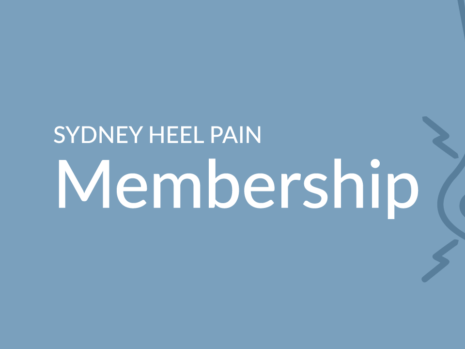Case Study September 2016 – Achilles Tendonitis In Both Feet
Achilles Tendonitis – Case History
A recreational runner, 33 years old, presents to the clinic complaining of Achilles Tendonitis. She has been enduring pain in both feet for more than 12 months and has reluctantly ceased running. She is 176cm tall and weighs approximately 58 kilos. She runs 5 days a week covering approximately 50 kilometres in total. Before the onset of her Achilles Tendonitis she covered a kilometre in around 3 minutes 50 seconds, however, since the injury this has slowed somewhat. Mrs X has registered for a half marathon in Sydney and is keen to get well for the event. She has never had Achilles Tendonitis before and boasts good foot health.
She reports that the Achilles Tendonitis is painful when she gets out of bed in a morning but eases off slightly as she walks. Throughout the day, the pain is sporadic. Sometimes, there is a noticeable pain when she stands up from a seated position and begins to walk. The pain is worse in the right leg, and in both cases the area of concern is above the heel bone, in the part of the tendon that can be seen and pinched with finger and thumb. During the first kilometre of a run, the tendons would feel stiff and sore. Afterwards, the Achilles Tendonitis was less painful as though the legs had warmed up. This allowed Mrs X to get through most of the run, before the pain would return towards the end. However, the pain that she felt around an hour later was severe and this would cause her to limp. The next morning, following a run, the Achilles Tendonitis was even worse and the pain excruciating.
Mrs X began to carry out on line research in an attempt to find web sites that offer advice on the treatment of Achilles Tendonitis. She came across some stretching and eccentric loading exercises, the latter of which made the pain worse. She began a course on NSAID’s in an attempt to reduce the inflammation to no avail. Her regular chiropractor informed her that he had experienced some joy in the past when treating Achilles Tendonitis. He would mobilise the foot and ankle joints and use acupuncture needles to loosen the calf. While there was some temporary pain relief from the acupuncture, the condition was not improving overall.
Achilles Tendonitis – Physical Examination
Mrs x had been suffering with Achilles Tendonitis for more than a year. There were visible signs of swelling in both tendons. There were nodules on both legs that were firm to touch. There was pain when gentle pressure was applied to the nodules with finger and thumb. There was no pain when pressure was applied to the insertion of the Achilles Tendon at the heel bone. As is typical with acute Achilles Tendonitis, this patient reported pain when she attempted a single leg calf raise.
Bio Mechanical Assessment for Achilles Tendonitis
Achilles Tendonitis can be painful when walking or running in bare feet, and can be exacerbated with an inclined running surface. Mrs X was observed on the treadmill without shoes so that her foot function could be analysed. Video was captured using digital software on an iPad. Data was captured during walking and running, on both a level surface and an inclined surface. During the walk, Mrs X did not report pain but when running, the Achilles Tendonitis was sore in both legs. The same was found on the inclined running surface.
During replay, it was evident that Mrs X had an inherent weakness in some of the joints of her feet. There was over pronation in both feet when walking, which became more severe when running. Her over pronation was taking place at the sub talar joint and this allows the Achilles Tendon to become stressed as it distorts.
Achilles Tendonitis Treatment
Mrs X was informed that her Achilles Tendonitis was chronic but also acute and to this end, there was to be a short and long term treatment approach. Primarily, due to the visible and palpable swelling, this patient was advised to apply ice packs to her tendons at least once a day for 30 minutes. A treatment plan of weekly Shock Wave Therapy sessions was put in place. The Shock Wave Therapy would stimulate blood flow and promote healing. There is also a pain relieving effect from the Shock Wave Therapy which gives patient’s an emotional break from the constant pain.
2 x 9mm heel lifts were inserted into the patient’s shoes in order to elevate the heel and unload the tendon. These were to be used for a month or 2, throughout treatment, until pain was almost gone and the Achilles Tendonitis seemed to have healed. Mrs X was advised to avoid walking bare foot and to either avoid or reduce the use of flat shoes or thongs. She was also asked to perform calf stretches with her feet supinated in order to release the tendon. She would be weaned off the heel lifts in due course.
Orthotic therapy is not always necessary in cases of Achilles Tendonitis, but with this patient there was clearly a bio mechanical issue with over pronation. This patient informed the Podiatrist that she wanted to do as much as possible to expedite the healing of her condition and ensure the Achilles Tendonitis healed completely, and so a pair of orthotics was arranged. The sports orthotics were made from lightweight Carbon Fibre and were covered with slow release poron for cushioning. These would replace the liner of her running shoes, which were deemed appropriate for her foot type.
8 Week Follow Up
Mrs X reported a marked improvement in her condition but was not yet running at her usual pace. She was running 3 days a week and wanted to return to 5 days and she was advised this will happen in due course, following a training programme. The morning pain had gone away completely, but was a little tender the morning after a run. Some stiffness was also apparent. The nodules had decreased in size and while they were not sore during walking, there was mild pain on palpation. This was to be expected and the patient was advised that further healing would take place in the coming weeks.
After 12 weeks there was further improvement and Mrs X was back to running 5 days a week. The heel lifts had been removed and calf muscle range was good. Mrs X was advised to return to the Podiatrist if her Achilles Tendonitis became sore again.
It should be noted that the information in this case study is not general advice. If you have Achilles Tendonitis you should seek the help of a Sports Podiatrist.
Written by Karl Lockett





